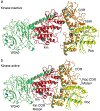Roc, the G-domain of the Parkinson's disease-associated protein LRRK2
- PMID: 35840518
- PMCID: PMC9669111
- DOI: 10.1016/j.tibs.2022.06.009
Roc, the G-domain of the Parkinson's disease-associated protein LRRK2
Abstract
Mutation in leucine-rich repeat (LRR) kinase 2 (LRRK2) is a common cause of Parkinson's disease (PD). Aberrant LRRK2 kinase activity is associated with disease pathogenesis and thus it is an attractive drug target for combating PD. Intense efforts in the past nearly two decades have focused on the development of small-molecule inhibitors of the kinase domain of LRRK2 and have identified potent kinase inhibitors. However, most LRRK2 kinase inhibitors have shown adverse effects; therefore, alternative-mechanism-based strategies are desperately needed. In this review, we discuss the new insights gleaned from recent cryoelectron microscope (cryo-EM) structures of LRRK2 towards understanding the mechanisms of actions of LRRK2 and explore the potential new therapeutic avenues.
Keywords: COR; GTPase; Roc; allosteric regulation; kinase; therapeutics.
Copyright © 2022 Elsevier Ltd. All rights reserved.
Conflict of interest statement
Declaration of interests No interests are declared.
Figures




Similar articles
-
Understanding the GTPase Activity of LRRK2: Regulation, Function, and Neurotoxicity.Adv Neurobiol. 2017;14:71-88. doi: 10.1007/978-3-319-49969-7_4. Adv Neurobiol. 2017. PMID: 28353279 Free PMC article. Review.
-
LRRK2 Structure-Based Activation Mechanism and Pathogenesis.Biomolecules. 2023 Mar 28;13(4):612. doi: 10.3390/biom13040612. Biomolecules. 2023. PMID: 37189360 Free PMC article. Review.
-
The Roc-COR tandem domain of leucine-rich repeat kinase 2 forms dimers and exhibits conventional Ras-like GTPase properties.J Neurochem. 2018 Nov;147(3):409-428. doi: 10.1111/jnc.14566. J Neurochem. 2018. PMID: 30091236
-
14-3-3 binding maintains the Parkinson's associated kinase LRRK2 in an inactive state.Nat Commun. 2025 Aug 5;16(1):7226. doi: 10.1038/s41467-025-62337-1. Nat Commun. 2025. PMID: 40764514 Free PMC article.
-
Markov State Models and Molecular Dynamics Simulations Provide Understanding of the Nucleotide-Dependent Dimerization-Based Activation of LRRK2 ROC Domain.Molecules. 2021 Sep 17;26(18):5647. doi: 10.3390/molecules26185647. Molecules. 2021. PMID: 34577121 Free PMC article.
Cited by
-
Recent advances in targeting LRRK2 for Parkinson's disease treatment.J Transl Med. 2025 Jul 8;23(1):754. doi: 10.1186/s12967-025-06354-0. J Transl Med. 2025. PMID: 40629324 Free PMC article. Review.
-
CalDAG-GEFI acts as a guanine nucleotide exchange factor for LRRK2 to regulate LRRK2 function and neurodegeneration.Sci Adv. 2024 Nov 22;10(47):eadn5417. doi: 10.1126/sciadv.adn5417. Epub 2024 Nov 22. Sci Adv. 2024. PMID: 39576856 Free PMC article.
-
Structural insights into the GTP-driven monomerization and activation of a bacterial LRRK2 homolog using allosteric nanobodies.Elife. 2024 Apr 26;13:RP94503. doi: 10.7554/eLife.94503. Elife. 2024. PMID: 38666771 Free PMC article.
-
Phosphorylation of AQP4 by LRRK2 R1441G impairs glymphatic clearance of IFNγ and aggravates dopaminergic neurodegeneration.NPJ Parkinsons Dis. 2024 Jan 31;10(1):31. doi: 10.1038/s41531-024-00643-z. NPJ Parkinsons Dis. 2024. PMID: 38296953 Free PMC article.
-
Development of mutation-selective LRRK2 kinase inhibitors as precision medicine for Parkinson's disease and other diseases for which carriers are at increased risk.Front Neurol. 2022 Oct 26;13:1016040. doi: 10.3389/fneur.2022.1016040. eCollection 2022. Front Neurol. 2022. PMID: 36388213 Free PMC article. No abstract available.
References
-
- Funayama M, Hasegawa K, Kowa H, Saito M, Tsuji S, Obata F: A new locus for Parkinson’s disease (PARK8) maps to chromosome 12p11.2-q13.1. Ann Neurol 2002, 51(3):296–301. - PubMed
-
- Zimprich A, Biskup S, Leitner P, Lichtner P, Farrer M, Lincoln S, Kachergus J, Hulihan M, Uitti RJ, Calne DB et al.: Mutations in LRRK2 cause autosomal-dominant parkinsonism with pleomorphic pathology. Neuron 2004, 44(4):601–607. - PubMed
-
- Paisan-Ruiz C, Jain S, Evans EW, Gilks WP, Simon J, van der Brug M, Lopez de Munain A, Aparicio S, Gil AM, Khan N et al.: Cloning of the gene containing mutations that cause PARK8-linked Parkinson’s disease. Neuron 2004, 44(4):595–600. - PubMed
-
- Ross OA, Wu YR, Lee MC, Funayama M, Chen ML, Soto AI, Mata IF, Lee-Chen GJ, Chen CM, Tang M et al.: Analysis of Lrrk2 R1628P as a risk factor for Parkinson’s disease. Ann Neurol 2008, 64(1):88–92. - PubMed
Publication types
MeSH terms
Substances
Grants and funding
LinkOut - more resources
Full Text Sources
Medical
Miscellaneous

